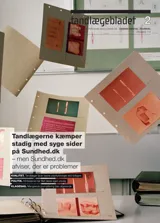Klinisk holdbarhed af plastbaserede fyldninger i permanente tænder
Denne oversigtsartikel beskriver holdbarhed af fyldninger i dagens plastbaserede materialer og bygger frem for alt på randomiserede kontrollerede (RCT)-studier. Langtidsundersøgelser af adhæsive systemer viser en kontinuerlig degradering af samtlige adhæsiver. I korttidsundersøgelser viser nyere selvætsende bindingssystemer lige så god klinisk retention som ”etch-andrinse”- adhæsiver i Klasse V-læsioner. Holdbarhed af omlagte amalgamfyldninger har længe været bedre end for plastfyldninger, men nye longitudinelle studier viser i mange tilfælde en holdbarhed for plast, som kan sidestilles med amalgam. De almindeligste årsager til omlægning af kompositfyldninger er sekundær caries og fraktur af fyldningsmateriale. Cariesrisikopatienter har vist signifikant højere risiko for at få sekundær caries i relation til plastfyldninger sammenlignet med amalgamfyldninger. Plast til restaurering af fortandshjørner viser sammenlignet med kompomer og resinmodificeret glasionomercement den højeste gennemsnitlige levetid (10 år). Der findes ikke evidens for, at kondenserbare, fiberforstærkede eller lavt skrumpende plastmaterialer har bedre klinisk effekt end konventionelle hybride plastmaterialer. Posteriore plastfyldninger med eller uden flowplast i den cervikale del af de approksimale kasser viser samme frekvens af vellykkede fyldninger i undersøgelser af op til syv års varighed. En plastfyldning udført med et godt materiale og en god fyldningsteknik har i dag mindre end 2 % mislykkede pr. år i 3-5-års studier. Faktorer som operatørens manuelle færdigheder og patientens cariesrisiko og parafunktioner har klart større betydning for fyldningens holdbarhed end plastmaterialets kontraktionsstress.
Longevity of resin based materials in permanent teeth This review covers durability of newer resin based materials primarily based on randomized controlled clinical trials (RCT). Long term follow ups of adhesive systems show a continued degradation of the bonding effect for all bonding systems. Short term follow ups of newer self-etch-systems in Class V lesions show an equal retention rate as for etch-and-rinse systems. Durability of replaced amalgam restorations have for a long time been better than for resin composites, but newer longitudinal studies show longevity of resin composites comparable to amalgams. The most frequent reasons for replacement of resin composite restorations are secondary caries and fracture of material. Caries risk patients show significantly higher caries frequency with contiguous resin composite compared to amalgam restorations. Resin composite compared to compomer and resin modified glass ionomer cement show the best mean survival (10 year) in Class IV restorations. No evidence is found for a better clinical efficacy with packable, fibre-reinforced and low shrinkage resin composites compared to conventional hybrid resin composites. Posterior resin restorations with or without flow-material in the cervical part of the approximal box show the same survival frequencies in up to 7-year follow ups. Today a resin composite restoration made in a material with good properties and performed with a good restorative technique has an annual failure rate of less than 2 % in 3-5 year follow ups. Factors such as skills of the operator, patient risk of caries and parafunctions probably influence the durability more than contraction stress in the resin composite.


